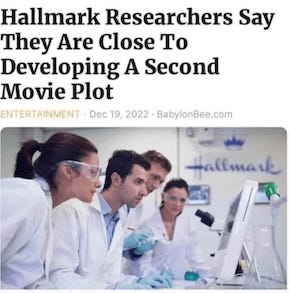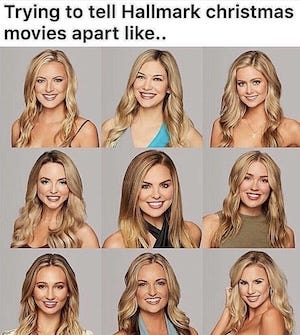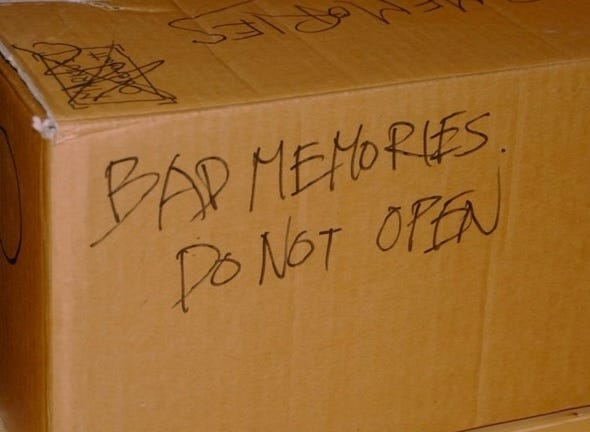Hallmark movies are magic tricks, written and acted by skilled magicians.
“Magicians, like poets and lovers, engage our mind in a permanent maze of possibilities. The trick is to renew the possibilities, to keep them from becoming schematized, to let them be imperfect.”
Adam Gopnik says this in The Real Work, his study of how extremely skilled individuals master their pursuits. In the book’s first section, Gopnik studies the world of magic and magicians, analyzing the psychological dance between magician and audience--and how each trick’s success depends on the participation of both parties.
Magic tricks can be separated into magic and trick. The trick is the optical illusion, sleight of hand, or bait-and-switch, requiring mechanics and technical know-how. Magic is the sense of wonderment the audience gets from engaging in fantasy—the "what if that were possible" suggestion that beyond our mundane reality lie thrilling possibilities.
Many articles analyzing the popularity of Hallmark’s holiday movies follow a formula: The writer notes Hallmark’s increasing viewership. They criticize their films for being “awful” (Vice), “corny,” (NBC News), and “bland” (Salon). Then they admit to enjoying them, adding a self-conscious footnote--an article in Vancouver magazine calls them “guilty pleasures.” Vice and Salon are known for being tastemakers. They pander to audiences who trust them to recommend innovative, sophisticated content. By reducing their enjoyment of Hallmark movies to an embarrassing impulse, these writers reassure the reader of their authority as curators, avoiding being labeled as unreliable for enjoying something widely perceived as “low-brow.”
Coinciding with the release of their annual holiday films (around 40 each year), Hallmark was the third-watched cable network channel in November 2024 (second to only ESPN and FOX). Despite the number of cable TV subscribers decreasing by 20 million since 2019, Hallmark’s audience continues to grow.
These writers don’t realize that disparaging Hallmark’s holiday movies, or apologizing for enjoying them, is an obstacle to answering the question of what audiences find alluring about them. They reduce Hallmark movies to an empty-calorie treat, satisfying a base human desire for comfort, predictable storylines, and happy resolutions.
Of all the ‘bad’ content on YouTube, cable TV, Netflix, and other streaming services, why do millions of viewers choose Hallmark’s holiday movies? A loyal fan base seeks them out, returning annually to see what holiday shenanigans are afoot. They are built into viewers’ holiday rituals.
Hallmark’s 2021 movie, Pumpkin Everything, dissects issues of career and family. As always, there’s a romantic storyline, but the love aspect of Pumpkin Everything features less prominently than the conflict between Amy, who left her small town to pursue her career, and Tom, her grandfather who hoped she would take over his fall-themed home goods store, Pumpkin Everything. Pumpkin Everything asks: Can a daughter redeem herself in the eyes of her father figure after failing to fulfill the dream he once had for her future? How can an estranged family accept one another’s differences?
Pumpkin Everything weaves a story of redemption, reconciliation, and the classic American dream of reinvention. Hallmark provides holiday magic in the form of seasonally relevant symbolism, and wonderment in the form of hope.
Pumpkin Everything opens on Amy, a writer living in a large, unnamed city and currently catching her big break: the third book in her vampire novel series, Vampire Rising, is blowing up. She’s already booked a national book tour and, as her agent informs her in the opening scene, has just been asked to appear on one of the nation’s most popular daytime television shows. Amy hardly believes it: that one’s passion can lead to wild financial success in a way so unexpected to be almost accidental, allowing you to quit your day job forever.
But Amy’s radiant mood is disrupted by a phone call from her mother: Amy’s grandfather, Tom, has been in a car accident. Though he’s only suffered a sprained wrist, Amy’s mother worries about his ability to care for himself and run his business.
Here’s where the movie starts: it’s formulaic, but the formula--the magic trick of unresolved conflict--is performed with a polished, clever style. It’s as if each Hallmark movie believes in its ability to convince the audience they can’t be sure what will happen next.
A good Hallmark movie, like a good magic trick, conceals the mechanics of its drama. Amy’s humility in the face of success makes her endearing, and her vampire novels give her a spunky, quirky appeal. The film’s ability to balance somber themes with a comforting, uplifting energy lies in Amy’s effervescent personality.
Tom doesn’t need surgery, or even PT. But his simple mistake—hitting the gas instead of the brake in a truck he’s been driving for possibly decades--guarantees there will be a “next time.” Tom’s minor injury reflects his flagging cognitive abilities, implying that he’s a little closer to death. This unspoken mortal threat to Tom’s life is the catalyst for Amy’s return to Autumboro--a place she’s avoided for the past 15 years.
When Tom discovered that Amy decided to pursue writing instead of taking over Pumpkin Everything, he revoked his offer to pay her college tuition. Now she’s returning home in a position of power: she no longer needs his money.
In Autumnboro, Amy gives Tom a ride home from the hospital. They banter about past years spent celebrating Foliage Fest together, whose 20th anniversary is fast approaching. Their shared nostalgia reanimates their enduring bond, but the upbeat mood is extinguished when Tom bristles at the mention of Amy’s book tour, shutting their conversation down.
This dilemma reflects a common family dynamic: a parent’s love conflicts with their refusal to recognize their adult child’s autonomy, even during a role reversal which positions the parent as weakened and needing care, and the child as the adult caretaker.
When Gopnik refers to the ‘imperfection’ of a trick, he’s talking about idiosyncrasies that make a classic, retold, otherwise predictable performance unique and captivating. You select a card from the deck, and your card appears under the magician’s hat. A crease or tear in the card makes the trick imperfect, or seem exceptional and renewed.
Pumpkin Everything’s “imperfections” lie in its characters and their unique histories; Amy’s vampire books seem silly and wild in stark contrast to the curated, predictable pumpkin life Tom wanted for her. Kit’s unique trauma--losing his mother at a young age and becoming erratic and volatile under the weight of his grief--adds depth and sensitivity to his character.
Kit is Amy’s estranged high school best friend and quintessential love interest. Coincidentally, he’s now the manager of Pumpkin Everything. Because the conflict in this movie focuses on family dynamics, Amy and Kit are quick to reconcile over a cup of cider. Their relationship plays on the “one that got away” trope; picking up where they left off, we know they’ll end up together, creating the shared future they once imagined before drifting apart. They’re already on the same page about Tom: Pumpkin Everything is depleting his increasingly limited energy as he ages.
New questions are raised as Amy extends her visit to hang out with Kit and participate in Foliage Fest: Will she jeopardize her book tour or career to remain in Autumnboro for her family, her love interest? She’s torn between two worlds: her independence and financial success in the big, emotionally vacant city, and the spiritual fulfillment of family life and community in her small, familiar hometown.
The fate of Pumpkin Everything hangs in the balance. When Amy outright begs Tom to sell the store he’s worked his entire adult life to create and nurture, Tom is pissed. Tom accuses Amy of being utterly incapable of understanding the horrors of growing old and feeble. We suddenly see that he feels abandoned by her, afraid of being alone. This moment makes him a more sympathetic character, his grumpiness peeled back to reveal vulnerability.
In a situation that might be messier in real life, Amy nods and frowns with angelic patience, sympathetic to Tom’s fears. In their somber conversation, Amy’s reaction is a wink to the audience: everything is going to work out--Hallmark’s signature.
During all the drama, the audience is treated to what they arrived for: the visual splendor of fall. Hallmark movies rely heavily on symbolism to act as their magician’s elaborate costume. We’re here for the leaf peeping, and the settings are crucial scaffolding for the script.
Autumnboro is a leafy, bucolic town. Wide, walkable sidewalks are lined with trees suspended in perfect autumn foliage. Arrangements of pumpkins and squash are piled in the background of almost every shot. Outside the cafe where Amy and her mother grab pumpkin spice lattes, haybales lie stacked beneath hanging baskets of yellow and red mums. Kit has decorated his apartment like he has Pumpkin Everything: fired stoneware jugs stuffed with ears of corn and wheat, orange foliage framing his expansive bay windows.
Hallmark movies offer an escape into an alternate universe in the same way obvious sci-fi and fantasy genre films do. Lord Of The Rings, Dune, and other fantasy stories are set in worlds governed by rules so different from our day-to-day reality, these rules must be set up and explained using expository information in order for the viewer to understand them. The parallel universe of Pumpkin Everything is so similar to our own that its differences need no explanation.
In the world of Autumnboro, the holiday season is guaranteed to be resplendent. This world is free from advertisements, billboards, or newspapers brandishing bleak headlines in tall, bold capital letters. No one is starving, homeless, or dying of an illness they cannot treat because they cannot afford healthcare. Understanding, empathy, and kindness are innate qualities all people possess. There aren’t even any lines to wait in or dense crowds to navigate. In Autumnboro, your spacious house is always clean, and you can always get a table at your favorite restaurant. The near-constant external stressors of the real world, capable of exacerbating a bad mood or further complicating fraught situations--simply do not exist. Closeups of Amy and other characters are bright with softened backgrounds, like a Zoloft commercial: nonthreatening, serene, lobotomized.
Midway through the movie, Amy conducts her anticipated daytime television interview in front of Pumpkin Everything to help Tom promote the store. As she speaks into the microphone, Tom gapes.
“This is more than just writing,” Tom says to Amy’s mother, “It’s like she’s managing her own business.”
After the interview, Tom tells Amy he wants to read Vampire Rising and sell copies in Pumpkin Everything. Amy is thrilled, and it seems like all is well in Autumnboro. But there are still 20 minutes left in the movie, so you know some other shit is about to go down.
Tom falls off a ladder while trying to change a lightbulb. Amy discovers him face down on the porch like a marooned Santa Claus. He finally agrees to sell Pumpkin Everything, surprising--who else?---Kit with the first down payment in the form of a bonus.
In the final scene of Pumpkin Everything, the town gathers at Night Cap, Fall Foliage week’s closing celebration. Tom has arranged for Amy’s first stop on her book tour to coincide with Night Cap, and makes an announcement commemorating Vampire Rising:
“When Amy told me she wanted to write vampire stories, those who know me can only imagine how I bristled. But once I cracked open ‘Vampire Rising,’ I realized it was the story of a family man, and how his want for the very best for his family had blinded him to the passions and the desires of the very people he cherished.”
Tom did more than read Amy’s book; he reflected on and found meaning in its plot. He used Vampire Rising to understand her, and see himself through her eyes.
I teared up at this scene.
Now both dead, my parents never read my writing--my father because he died before I took my talents seriously, and my mother for reasons I can’t account for. Sometimes I sent her samples of my work, and she told me she would read them later. Eventually, I stopped sending them.
My first thought after wiping away my tears was cynical: you got me, Hallmark, you motherfuckers. I spent most of my childhood and early adult life believing I could protect myself from emotional pain by cultivating a steely outer shell, stoic and aloof. I squinted my eyes at Pumpkin Everything, suspecting Hallmark tricked me into experiencing emotions I related to events within my own family, tapping into my unanswered wish for my mother to read my work.
In reality, my emotions disturbed me. Because I find it painful, I don’t often contemplate how I wish my parents could see my Substack, which has almost 2,000 monthly subscribers, or what they might say in response to my essays. Their reconciliation comforted me, like I could imagine that kind of interaction happening for myself. At the least, seeing their reconciliation provided me with the hope that it was possible.
After Tom’s speech, Amy stands with Kit on the sidelines, watching the festivities, having just learned he’s purchasing Pumpkin Everything.
“Here,” Amy says. Kit hits her with a confused look.
“Right now. This is where I want to be.” They link hands.
“I’ll never get in the way of your writing,” he promises. Amy realizes that she can have it all: her writing career, a loving relationship, a close bond with her family, and Pumpkin Everything. She doesn’t have to sacrifice her personal goals to achieve the total life she wants. This is often not true of real life. In Pumpkin Everything, conflict is resolved in the closed circuit of Hallmark’s signature world. As they kiss, a blinding ray of sunshine beams between their faces, illuminating them in a heavenly light. The credits roll.
In the real world, fall foliage can seem like the background to a world on fire. Relationships have no guaranteed positive outcomes, despite how badly each person may crave resolution. Picking up your phone seems to promise a jump-scare of bad news: suffering, injustice, corporations destroying the environment without consequence, an uncertain future in a time of political unrest.
Hallmark creates its “maze of infinite possibilities” with films that reinvent classic stories set against nostalgic and seasonal imagery. Characters with unique circumstances engage the audience in refurbished experiences of wonder and hope.
Pumpkin Everything offers viewers an escape into a world where the answer to the question, “Could it really be that easy?” Is a resounding “yes.”













Damn it, Drew. Now you've got me one melancholy afternoon away from watching my first-ever Hallmark movie.
Excellent as always and a fantastic perspective on the Hallmark movie machine. They know how to pull those strings in our minds sometimes, and how they do it with basically 3 or 4 plots I'll never understand.